Related Research Articles

The púca, puca, also pwca, pookah, phouka, and puck, is a creature of Celtic, English, and Channel Islands folklore. Considered to be bringers both of good and bad fortune, they could help or hinder rural and marine communities. Púcaí can have dark or white fur or hair. The creatures were said to be shape-changers that could take the appearance of horses, goats, cats, dogs, and hares. They may also take a human form, which includes various animal features, such as animal ears or a tail.

The bogeyman is a mythical creature typically used to frighten children into good behavior. Bogeymen have no specific appearances, and conceptions vary drastically by household and culture, but they are most commonly depicted as masculine or androgynous monsters that punish children for misbehavior. The bogeyman, and conceptually similar monsters can be found in many cultures around the world. Bogeymen may target a specific act or general misbehaviour, depending on the purpose of invoking the figure, often on the basis of a warning from an authority figure to a child. The term is sometimes used as a non-specific personification of, or metonym for, terror – and sometimes the Devil.
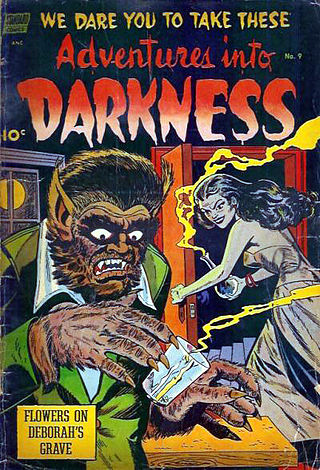
Werewolf fiction denotes the portrayal of werewolves and other shapeshifting therianthropes, in the media of literature, drama, film, games and music. Werewolf literature includes folklore, legend, saga, fairy tales, Gothic and horror fiction, fantasy fiction and poetry. Such stories may be supernatural, symbolic or allegorical. A classic cinematic example of the theme is The Wolf Man (1941) which in later films joins with the Frankenstein Monster and Count Dracula as one of the three famous icons of modern day horror. However, werewolf fiction is an exceptionally diverse genre, with ancient folkloric roots and manifold modern re-interpretations.
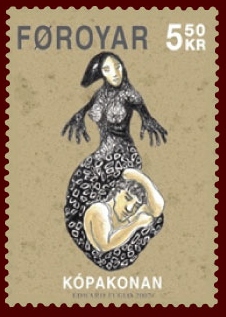
Selkies are mythological creatures that can shapeshift between seal and human forms by removing or putting on their seal skin. They feature prominently in the oral traditions and mythology of various cultures, especially those of Celtic and Norse origin. The term “selkie” derives from the Scots word for “seal”, and is also spelled as silkies, sylkies, or selchies. Selkies are sometimes referred to as selkie folk, meaning 'seal folk'. Selkies are mainly associated with the Northern Isles of Scotland, where they are said to live as seals in the sea but shed their skin to become human on land.
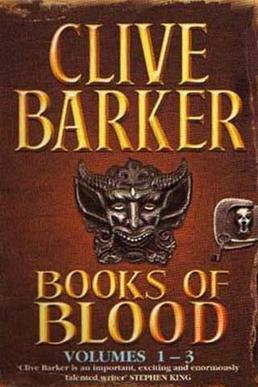
Books of Blood is a series of six horror fiction anthologies collecting original stories written by British author, playwright, and filmmaker Clive Barker in 1984 and 1985. Known primarily for writing stage plays beforehand, Barker gained a wider audience and fanbase through this anthology series, leading to a successful career as a novelist. Originally presented as six volumes, the anthologies were subsequently re-published in two omnibus editions containing three volumes each. Each volume contains four, five or six stories. The Volume 1–3 omnibus contained a foreword by Barker's fellow Liverpudlian horror writer Ramsey Campbell. Author Stephen King praised Books of Blood, leading to a quote from him appearing on the first US edition of the book: "I have seen the future of horror and his name is Clive Barker."
Catman may refer to:

Catman is a character appearing in comic books published by DC Comics. He is part of Batman’s growing roster of enemies, debuting in the mid-1960s.

The each-uisge is a water spirit in Irish and Scottish folklore, spelled as the each-uisce in Ireland and cabbyl-ushtey on the Isle of Man. It usually takes the form of a horse, and is similar to the kelpie but far more vicious.

"Dagon" is a short story by American author H. P. Lovecraft. It was written in July 1917 and is one of the first stories that Lovecraft wrote as an adult. It was first published in the November 1919 edition of The Vagrant. Dagon was later published in Weird Tales in October 1923. It is considered by many to be one of Lovecraft's most forward-looking stories.
"The Unnamable" is a horror short story by American author H. P. Lovecraft. It was written in September 1923, first published in the July 1925 issue of Weird Tales, and first collected in Beyond the Wall of Sleep. The corrected text appears in Dagon and Other Macabre Tales,. The story's locale was inspired by the Charter Street Historic District Burying Ground in Salem.

The Whisperer in Darkness is a 26,000-word novella by American writer H. P. Lovecraft. Written February–September 1930, it was first published in Weird Tales, August 1931. Similar to The Colour Out of Space (1927), it is a blend of horror and science fiction. Although it makes numerous references to the Cthulhu Mythos, the story is not a central part of the mythos, but reflects a shift in Lovecraft's writing at this time towards science fiction. The story also introduces the Mi-Go, an extraterrestrial race of fungoid creatures.

The fish-man of Liérganes is an entity of the mythology of Cantabria, located in the north of Spain. The fish-man would be an amphibian human-looking being, who looked a lot like a metamorphosis of a real human being who was lost at sea. His story was examined by Enlightenment writer Benito Jerónimo Feijoo, who claimed that the story was true.
The Yara-ma-yha-who is a legendary vampiric monster found in Southeastern Australian Aboriginal mythology. The legend is recounted by David Unaipon. According to legend, the creature resembles a little red frog-like man with a very big head, a large mouth with no teeth and suckers on the ends of its hands and feet.

Approaching Oblivion is a collection of eleven short stories by American author Harlan Ellison. They had appeared in various magazines throughout the early 1970s with the exceptions of "Paulie Charmed the Sleeping Woman" which originally appeared in 1962 and "Ecowareness" which was previously unpublished.

Colombian folklore are beliefs, customs and cultural traditions in Colombia.
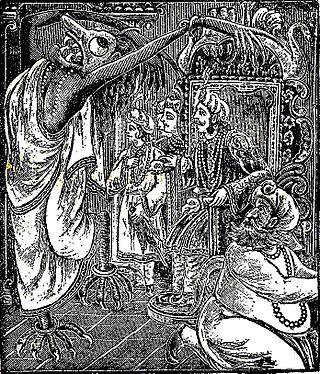
Ghosts are an important and integral part of the folklore of the socio-cultural fabric of the geographical and ethno-linguistic region of Bengal which presently consists of Bangladesh and the Indian states of West Bengal and Tripura. Bengali folktales and Bengali cultural identity are intertwined in such a way that ghosts depicted reflect the culture it sets in. Fairy tales, both old and new, often use the concept of ghosts. References to ghosts are often found in modern-day Bengali literature, cinema, radio and television media. There are also alleged haunted sites in the region. The common word for ghosts in Bengali is bhoot or bhut. This word has an alternative meaning: 'past' in Bengali. Also, the word Pret is used in Bengali to mean ghost. In Bengal, ghosts are believed to be the unsatisfied spirits of human beings who cannot find peace after death or the souls of people who died in unnatural or abnormal circumstances like murders, suicides or accidents. Non-human animals can also turn into ghosts after their death. But they are often associated with good luck and wealth in Bangladesh.

Talking animals are a common element in mythology and folk tales, children's literature, and modern comic books and animated cartoons. Fictional talking animals often are anthropomorphic, possessing human-like qualities. Whether they are realistic animals or fantastical ones, talking animals serve a wide range of uses in literature, from teaching morality to providing social commentary. Realistic talking animals are often found in fables, religious texts, indigenous texts, wilderness coming of age stories, naturalist fiction, animal autobiography, animal satire, and in works featuring pets and domesticated animals. Conversely, fantastical and more anthropomorphic animals are often found in the fairy tale, science fiction, toy story, and fantasy genres.
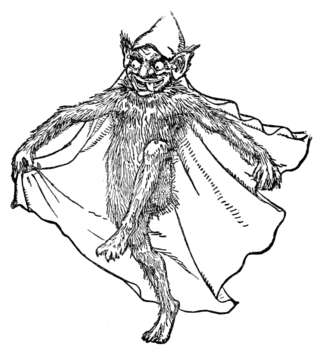
A goblin is a small, grotesque, monstrous humanoid creature that appears in the folklore of multiple European cultures. First attested in stories from the Middle Ages, they are ascribed conflicting abilities, temperaments, and appearances depending on the story and country of origin, ranging from mischievous household spirits to malicious, bestial thieves. They often have magical abilities similar to a fairy or demon, such as the ability to shapeshift.
"The Fornicating Dog" is a short story by Chinese author Pu Songling first published in Strange Stories from a Chinese Studio (1740). The story pertains to a Chinese merchant's spouse, a zoophile who develops sexual relations with the family's pet dog; Pu himself was critical of such phenomena as sexual fixation on animals. It was dropped from early editions, both Chinese and translated, of Liaozhai, notwithstanding Pu's original manuscript, and was translated into English by John Minford in 2006.
References
- ↑ A Mysterious Creature causes panic in Santa Fe Archived 2007-03-22 at the Wayback Machine (Spanish)
- ↑ "El Hombre Gato", a short story by Juan Diego Incardona